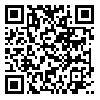BibTeX | RIS | EndNote | Medlars | ProCite | Reference Manager | RefWorks
Send citation to:
URL: http://salmandj.uswr.ac.ir/article-1-1307-en.html
2- Department of Social Sciences, Faculty of Social Sciences, Parand Branch, Payame Noor University, Parand, Iran.
Objectives The goal of the study is to compare the social capitals of two groups of families (families with and without the elderly).
But some scholars of social sciences have introduced family life as the ashlar of social capital and have stated that the root of today’s social chaos is the lack or absence of it.
So family as an independent capital has a close relationship with other important capitals in the society. Therefore, reinforcing and consolidating family and bringing ethics back to family and its members are the responsibilities of public that may promote the important social capitals.
Methods & Materials The current study has been done on the authentic statistical society consisting of 384 people from families of four-fold areas of Qom using the survey method, questionnaire technique, and cluster and accidental samples. So, with regards to social and conventional criteria, the city was divided into 5 regions, and then one street was chosen randomly in each of those regions. Then according to the population in each region, 100 respondents were randomly selected from one or two blocks in each region for this study. A total of 97% of the respondents were male, and 8% were female. Half (50%) of the respondents were in the age group of 26 to 55 years, 33% were aged 36 to 45 years, and the other 17% were over 45 years of age.
Results We found that there was no meaningful difference between intra-familial cognitive social capital between two groups with or without the elderly. However, there was a significant difference between the groups with respect to capital and external cognitive structural social.
No significant difference was observed between the two groups with respect to the basic variables such as gender, education, age, the number of children, and occupation.
Conclusion Based on the obtained results, it can be said that the presence of elderly in the family increases family social capital and decreases major moral issues in the society.
Governments, supporting the elderly and their needs, including health care and pharmaceutical costs, economic supports, etc., provide conditions for the elderly to accompany their children and increase family social capital.
Received: 2017/09/09 | Accepted: 2017/12/31 | Published: 2018/06/22
| Rights and permissions | |
 |
This work is licensed under a Creative Commons Attribution-NonCommercial 4.0 International License. |







